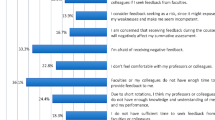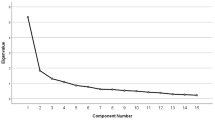Abstract
OBJECTIVE: To determine whether residents perceived oral, face-to-face feedback about their continuity clinic performance as better than a similar, written version.
DESIGN: Single-blind, randomized controlled trial.
SETTING: Two university-based, internal medicine residency clinics.
PARTICIPANTS: All 68 internal medicine and combined program (medicine-pediatrics, medicine-psychiatry, medicine-neurology, and preliminary year) residents and their clinic preceptors.
MEASUREMENTS AND MAIN RESULTS: Residents at each program were separately randomized to oral or written feedback sessions with their clinic preceptors. The oral and written sessions followed similar, structured formats. Both groups were later sent questionnaires about aspects of the clinic. Sixty-five (96%) of the residents completed the questionnaire. Eight of the 19 questions dealt with aspects of feedback. A feedback scale was developed from the survey responses to those eight questions (α=.86). There were no significant differences in the responses to individual questions or in scale means (p>.20) between the two feedback groups. When each university was analyzed separately, one had a higher scale mean (3.10 vs 3.57, p=.047), but within each university, there were no differences between the oral and written feedback groups (p>.20).
CONCLUSIONS: No differences were observed between the oral and written feedback groups. In attempting to provide better feedback to their residents, medical educators may better apply their efforts to other aspects, such as the frequency of their feedback, rather than the form of its delivery.
Similar content being viewed by others
References
Robins LS, Gruppen LD, Alexander GL, Fantone JC, Davis WK. A predictive model of student satisfaction with the medical school learning environment. Acad Med. 1997;72:134–9.
Gil DH, Heins M, Jones PB. Perceptions of medical school faculty members and students on clinical clerkship feedback. J Med Educ. 1984;59:856–64.
Irby DM. Three exemplary models of case-based teaching. Acad Med. 1994;69:947–53.
Irby DM. What clinical teachers in medicine need to know. Acad Med. 1994;69:333–42.
Frye AW, Hollingsworth MA, Wymer A, Hinds MA. Clinical assessment dimensions of feedback in clinical teaching: a descriptive study. Acad Med. 1996;71:S79–82.
Bing-You RC, Greenburg LW, Wiederman BL, Smith CS. A randomized multicenter trial to improve resident teaching with written feedback. Teach Learn Med. 1997;9:10–3.
Opila DA. The impact of feedback to medical housestaff on chart documentation and quality of care in the outpatient setting. J Gen Intern Med. 1997;12:352–6.
Ende J. Feedback in clinical medical education. JAMA. 1983;250:777–81.
Bing-You RG, Stratos GA. Medical students’ needs for feedback from residents during the clinical clerkship year. Teach Learn Med. 1995;7:172–6.
Schwartz S, Griffin T. Comparing different types of performance feedback and computer-based instruction in teaching medical students how to diagnose acute abdominal pain. Acad Med. 1993;68:862–4.
DeVellis RF. Guidelines in scale development. In: Scale Development: Theory and Applications. Newbury Park, Calif: Sage; 1991:51–91.
Wilkerson L, Armstrong E, Lesky L. Faculty development for ambulatory teaching. J Gen Intern Med. 1990;5:S44–53.
Lesky LG, Borkan SC. Strategies to improve teaching in the ambulatory medicine setting. Arch Intern Med. 1990;150:2133–7.
Orlander JD, Fincke G. Soliciting feedback on becoming an effective clinical teacher. J Gen Intern Med. 1994;9:334–5.
Hollingsworth MA, Richards BF, Frye AW. Description of observer feedback in an objective structured clinical examination and effects on examinees. Teach Learn Med. 1994;6(1):49–53.
Schum TR, Yindra KJ. Relationship between systematic feedback to faculty and ratings of clinical teaching. Acad Med. 1996;71(10):1100–2.
Hayward RA, Williams BC, Gruppen LD, Rosenbaum D. Measuring attending performance in a general medicine outpatient clinic. J Gen Intern Med. 1995;10:504–10.
Ways M, Kroenke K, Umali J, Buchwald D. Morning report: a survey of resident attitudes. Arch Intern Med. 1995;155:1433–8.
Author information
Authors and Affiliations
Additional information
Supported by the Department of Medicine, West Virginia University. Presented in part at the Society of General Internal Medicine annual meeting, 1995.
Rights and permissions
About this article
Cite this article
Elnicki, D.M., Layne, R.D., Ogden, P.E. et al. Oral versus written feedback in medical clinic. J GEN INTERN MED 13, 155–158 (1998). https://doi.org/10.1046/j.1525-1497.1998.00049.x
Issue Date:
DOI: https://doi.org/10.1046/j.1525-1497.1998.00049.x




